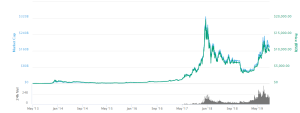Bitcoin Price Volatility: A Comprehensive Analysis
Unravel the mysteries of Bitcoin’s wild price swings! Dive into our in-depth analysis of market forces, historical trends, and future predictions for Bitcoin’s USD value. Get ahead of the curve!
The price of Bitcoin‚ denominated in US dollars‚ has experienced dramatic fluctuations since its inception. Understanding these swings requires analyzing a complex interplay of factors‚ ranging from macroeconomic conditions to technological advancements and regulatory pressures. This comprehensive analysis delves into the key drivers influencing Bitcoin’s USD price‚ exploring historical trends‚ current market dynamics‚ and potential future scenarios. We aim to provide a nuanced perspective‚ acknowledging both the inherent volatility and the long-term potential of this revolutionary cryptocurrency.
Historical Volatility and Key Price Drivers
Bitcoin’s journey has been marked by periods of explosive growth followed by significant corrections. Early adopters witnessed phenomenal returns‚ while later entrants encountered considerable risk. The initial years saw the price hovering around negligible amounts‚ gaining traction only after gaining recognition as a viable alternative to traditional financial systems. Subsequent price surges were often fueled by media hype‚ technological breakthroughs‚ and increasing institutional adoption. However‚ equally sharp declines followed‚ triggered by regulatory uncertainty‚ security breaches‚ or macroeconomic downturns.
Macroeconomic Factors Influencing Bitcoin’s Price
Global economic events play a crucial role in shaping Bitcoin’s price trajectory. Periods of economic uncertainty‚ such as the 2008 financial crisis or the recent COVID-19 pandemic‚ often lead to increased demand for Bitcoin as investors seek alternative stores of value. Inflationary pressures in established economies can also drive investors towards Bitcoin‚ perceived as a hedge against inflation. Conversely‚ positive economic news or strengthening of fiat currencies might lead to a decline in Bitcoin’s price as investors shift their focus back to traditional assets.
Interest rate hikes by central banks‚ for instance‚ impact the attractiveness of Bitcoin relative to other assets. Higher interest rates typically boost the value of government bonds and other fixed-income securities‚ potentially diverting capital away from riskier assets like Bitcoin. Conversely‚ periods of low or negative interest rates might stimulate investment in Bitcoin as investors seek higher returns.
Technological Advancements and Network Effects
Technological innovations within the Bitcoin network itself significantly influence its price. Upgrades to the underlying blockchain technology‚ such as the implementation of the Lightning Network‚ can enhance scalability and transaction speed‚ thereby increasing adoption and potentially driving up the price. Conversely‚ any perceived weaknesses or vulnerabilities in the network’s security could trigger a price decline.
Network effects also play a vital role. As more users and businesses adopt Bitcoin‚ the network becomes more valuable and resilient‚ fostering a positive feedback loop that can lead to price appreciation. This increased network effect solidifies Bitcoin’s position as a decentralized and censorship-resistant digital asset.
Regulatory Landscape and Institutional Adoption
Government regulations and the stance of financial institutions significantly impact Bitcoin’s price. Favorable regulations‚ such as the clear legal framework for cryptocurrency trading in certain jurisdictions‚ can lead to increased institutional investment and broader market acceptance. Conversely‚ stringent regulations or outright bans on cryptocurrency trading can negatively impact Bitcoin’s price.
Institutional adoption is a key driver of price volatility. When major financial institutions‚ such as investment firms and banks‚ start incorporating Bitcoin into their portfolios‚ it signals a degree of legitimacy and reduces the perception of Bitcoin as a purely speculative asset. This increased institutional participation often leads to price appreciation.
Geopolitical Events and Market Sentiment
Geopolitical events can profoundly affect Bitcoin’s price. Periods of global instability or uncertainty can boost demand for Bitcoin as investors seek a safe haven asset. For example‚ during times of political turmoil or international conflicts‚ investors might turn to Bitcoin’s decentralized and censorship-resistant nature. Conversely‚ periods of global stability might lead to investors shifting away from Bitcoin towards more traditional assets.
Market sentiment‚ driven by news cycles and social media trends‚ also plays a significant role. Positive news coverage or endorsements from influential figures can boost investor confidence and drive up the price. Conversely‚ negative news or criticisms of Bitcoin can trigger sell-offs and price declines;
Predicting Future Bitcoin Price: Challenges and Possibilities
Predicting the future price of Bitcoin is an extremely challenging endeavor. The inherent volatility of the cryptocurrency market‚ coupled with the complex interplay of factors discussed above‚ makes accurate forecasting exceptionally difficult. Technical analysis‚ fundamental analysis‚ and even sophisticated machine learning models have shown limited success in predicting long-term price movements.
However‚ several factors suggest potential future scenarios. Widespread adoption of Bitcoin as a means of payment‚ coupled with increased institutional investment and further technological advancements‚ could drive significant price appreciation. Conversely‚ increased regulatory scrutiny‚ security breaches‚ or the emergence of competing cryptocurrencies could exert downward pressure on the price.
Factors to Consider for Future Price Predictions
- Global Economic Conditions: Recessions or inflationary pressures can significantly affect Bitcoin’s value.
- Regulatory Developments: Clear and consistent regulations can foster growth‚ while stringent policies can hinder it.
- Technological Advancements: Improvements in scalability and security enhance Bitcoin’s appeal.
- Institutional Adoption: Continued institutional investment provides stability and price support.
- Market Sentiment: Positive news and widespread adoption can fuel price increases.
Bitcoin’s price in US dollars has a long and volatile history‚ shaped by a complex interplay of macroeconomic factors‚ technological advancements‚ regulatory developments‚ and market sentiment. Predicting its future price remains a challenging task‚ yet understanding the key drivers allows for a more informed assessment of potential scenarios. While inherent volatility persists‚ the long-term potential of Bitcoin remains a significant factor for investors and businesses alike. Continuous monitoring of these influential factors is crucial for navigating the dynamic landscape of the Bitcoin market. Careful consideration and diversification of investment strategies are paramount in mitigating risk. The future of Bitcoin’s price remains unwritten‚ but its impact on the global financial system is undeniable.







